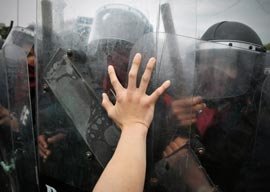
April 29, 2015

Source: Shutterstock
Eventually repression and tyranny backfired. The State apparatus and its leaders across Europe adopted the very tactics and practices they feared in their opposition; they became the kind of terrorists they had attempted to crush. By transforming into their own worst nightmare, they brought about the revolutions (e.g., the Revolutions of 1848) they meant to avoid and inspired the movements they intended to eradicate.
Entrapment, espionage, propaganda, tyranny, sedition, secrecy, conspiracy, treachery, reaction, regime”it’s all here, and it reveals that the operations of power are counterintuitive and complex, even if they”re logical. Hesitant to draw parallels with our present managerial nation states and their version of authoritarian rule, Zamoyski nevertheless marshals enough evidence and insinuation to make speculation about the current order inevitable.
There’s the shadow of Foucault in the background: Zamoyski portrays power as dependent on its lack, exploring how those with authority allow certain freedoms to then suppress them. There’s no power that’s not power over something. Permitting only such personal autonomy and agency as could be subdued enabled European governments to put their authority on display. States manufacture resistance to exercise”indeed show off”their muscle.
With their sprightliness these chapters win for themselves a certain charm. Zamoyski has not just recounted the sequence of events during a fascinating era but exposited an exciting theory about them and the forces driving them. It’s too soon to understand the logic behind the rumors, and the disinformation, we know world powers spread today. Zamoyski provides no direction to this end. He does, however, use history to awaken our imagination to the workings of global power structures, forcing us to ask questions and seek answers about the phantoms of terror that continue to haunt us.